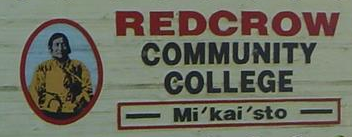Okonok – Amelanchier alnifolia (Nutt.) Nutt. ex M. Roemer (Service Berry, June Berry, Real berry)
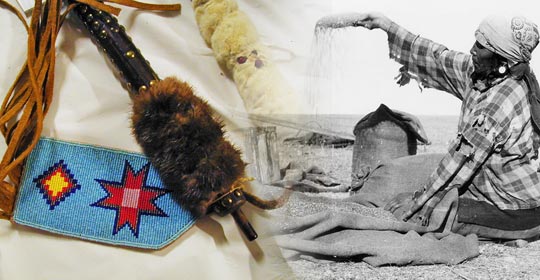
Traditional beadwork and a Blackfoot woman drying Saskatoon berries.
(Glenbow Museum. (2005). Nitsitapiisinni Exhibit.
Calgary, Alberta: Blackfoot Gallery Committee)
(Photo courtesy of Glenbow Museum Archives NA-667-343)
Okonok
Okonokiono iikitawakaohko’tsimo’p. Aowato’p omi miini, ihtaisaamsko’p ki omi miistsi ihta’paistotsi’p ihtayisitapiyo’pistsi. Iikayaahsii okonokistsi aistsitsaisiiko’tsi’kia tsahtao i’kamsskssiikiaw.Ihtwaooso’p ki matohtaiyookimo’p.Iikitapssoka’pi i’kamaistsisokowaanio’ki ki kohkinakinnoonistsi. Matsitapssoka’pi aaapan. Ni’takaiksamaikowan (Pete Standing Alone) annikkiw okonokionoikanikksiistsi ihta’paistotsi’p aahkoyinnimaan appssi,ki o’towa’tsis. Matohta’paisstotakio’p istahtsikima’tsis.
Saskatoon
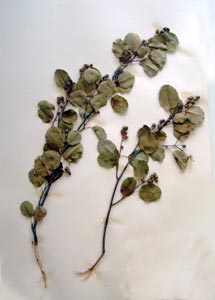
Amelanchier alnifolia (Nutt.) Nutt. ex M. Roemer
Galileo Educational Network
The Saskatoon plant gives us food to eat, medicine and wood for building things.
The berries are really good just picked but you can also dry them and store them. When the berries are dried, you can boil them in water with a bit of fat and make a soup with it. Soup made from this berry is served at ceremonies and was a staple used year round. Dried berries are mixed with fat and dried meat to make pemmican, a dried food stored for use year round. When it cools, it makes a delicious drink. Flavoring stew meat with the berries is also a delicious way to cook them.
The Saskatoon berry is an important berry for digestion. It helps our bodies break down animal protein. Berry juice works for constipation or an upset stomach. The tea also helps strengthen your liver to get rid of toxins. In our elder’s time, a nursing mother would drink this tea to pass on the medicine to her baby if the baby had an upset stomach or gas. The berry also strengthens our blood and keeps our veins clear. A tea of dried berries put on a cloth helps soothe sore eyes.
Fresh berries can be crushed and used to dye cloth and hides. Elder Pete Standing Alone told us that the branches of the Saskatoon make good pipe stems, arrow shafts, and tongs. The branches also make good tamp poles.
The Saskatoon plant is an important symbol in many of our ceremonies. Sometimes its branches and roots are mixed with tobacco to smoke for praying.
Saskatoons grow from 30 cm tall to trees of 4.5 metres. Look for them in our ravines on the prairie or with aspen poplar trees. The bark is brown or gray and smooth. Its branches hold leaves that are round or oval, 12-44 mm long, with little saw teeth all around the edges. When the Saskatoon flowers in June, you can see white flowers with 5 rounded petals at the end of the branches. When the berries come in July, they are a red purple colour and they ripen to a dark purple. The little berries, about 1 cm in diameter, are very sweet when they are ripe.
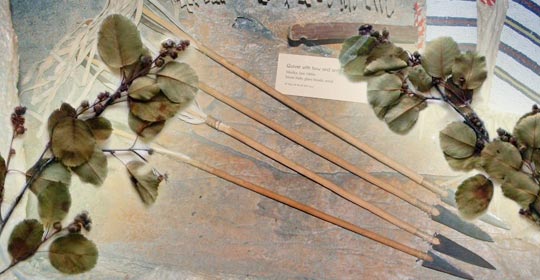
Dried Saskatoon leaves with arrows from the Glenbow Museum Exhibit.
(Glenbow Museum. (2005). Nitsitapiisinni Exhibit.
Calgary, Alberta: Blackfoot Gallery Committee)
Amélanchier

Amelanchier alnifolia (Nutt.) Nutt. ex M. Roemer
Galileo Educational Network
L’amélanchier est une source de nourriture, de remèdes et de bois de construction.
Ses fruits sont très bons lorsqu’ils sont frais cueillis, mais ils peuvent aussi être séchés afin d’être mangés plus tard. Quand ils sont séchés, nous pouvons les faire bouillir dans l’eau avec un peu de gras pour en faire une soupe. Nos aînés servaient cette soupe lors de cérémonies spéciales. Aussi, nos aînés écrasaient les fruits séchés avec une pierre et les mélangeaient avec du gras et de la viande séchée pour faire du pemmican, un aliment sec que nous gardions pour l’hiver. Il est aussi possible d’ajouter de l’eau chaude aux fruits séchés et écrasés avec un peu de farine. Une fois refroidi, ce mélange donne une délicieuse boisson. La viande à ragoût peut également être assaisonnée avec ces fruits.
L’amélanche est un fruit qui aide beaucoup la digestion. Elle aide notre corps à décomposer les protéines animales. Le jus de ce fruit enraye la constipation ou les maux d’estomac. Du thé de feuilles d’amélanches, mélangé au cambium du cerisier de Virginie aide notre corps à se débarrasser de ce qui nous rend malade. Aussi, le thé renforce notre foie pour qu’il puisse mieux éliminer les toxines. Dans le temps de nos aînés, la mère allaitante buvait ce thé afin de le transmettre à son bébé s’il avait des coliques ou des gaz. L’amélanche renforce notre sang et éclaircit le sang de nos veines. Un morceau de tissu imbibé de thé de fruits séchés aide à guérir les maux de yeux.
Les fruits frais écrasés peuvent servir à teindre des tissus et des peaux.
L’aîné Pete Standing Alone nous a aussi dit que les branches d’amélanchier font de bons tuyaux de pipes et fûts de flèches. Ces branches permettent aussi de fabriquer de bons pilons.
L’amélanchier joue un rôle important dans grand nombre de nos cérémonies. Parfois, nous mélangeons ses branches et ses racines avec du tabac que nous fumons pendant nos prières.
L’amélanchier peut passer d’un arbuste de 30 centimètres à un arbre de 4,5 mètres éventuellement. Nous pouvons l’apercevoir dans les ravins de nos prairies ou près des groupements de peupliers faux-trembles. Son écorce lisse est brune ou grise. Les feuilles de l’amélanchier sont rondes ou ovales. Elles mesurent de 12 à 44 millimètres de long et sont dentelées. Quand l’amélanchier fleurit en juin, de petites fleurs blanches à cinq pétales poussent au bout de ses branches. Quand les fruits sortent en juillet, ils sont de couleur rouge-pourpre, après quoi ils prennent une couleur violette une fois mûrs. Les amélanches, d’environ 1 centimètre de diamètre, sont très sucrées quand elles sont mûres.
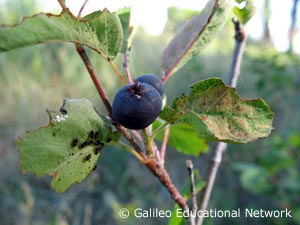
Amelanchier alnifolia (Nutt.) Nutt. ex M. Roemer
Galileo Educational Network
- Blackfoot Gallery Committee. (2001). The Story Of The Blackfoot People. Toronto: Keyporter Books.
- Glenbow Museum. (2005). Nitsitapiisinni Exhibit Calgary, Alberta: Blackfoot Gallery Committee.
- Hellson, John C. (1974). Ethnobotany of the Blackfoot Indians. Ottawa: National Museums of Canada.
- Johnston, Alex. (1987). Plants and the Blackfoot. Lethbridge, Alberta: Lethbridge Historical Society.
- Kerik, Joan. (1979). Living With The Land: Use of Plants by the Native People Of Alberta. Edmonton, Alberta: Provincial Museum of Alberta.
- Mountain Horse, Alvine and Narcisse Blood. (personal communications August 2008).
- Mountain Horse, Mike. (1979). My People The Bloods. Calgary, Alberta: Glenbow Museum.
- Moerman, Daniel E. (1998). Native American Ethnobotany. Portland: Timber Press.
- Standing Alone, P. (personal communication October 28, 2004)referred to Saskatoons.
- Vance, F.R., Jowsley, J.R. & Mclean, J.S. (1984). Wildflowers Across The Prairies. Saskatoon, Saskatchewan: Western Producer Prairie Books.



